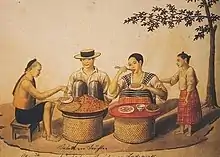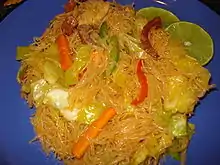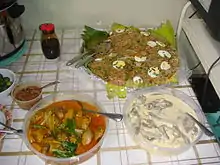Pancit
In Filipino cuisine, pancit are noodles and the dishes made from them, usually made with rice noodles. Noodles were introduced into the Philippines by Chinese immigrants in the archipelago, and over the centuries have been fully adopted into local cuisine, of which there are now numerous variants and types. The term, pancit (or the standard but less commonly spelled, pansit), is derived from either the Philippine Hokkien Chinese: 扁食; Pe̍h-ōe-jī: pán-si̍t/pián-si̍t; lit. 'wonton (noodles)' or Philippine Hokkien Chinese: 便的食; Pe̍h-ōe-jī: piân-ê-si̍t/pân-si̍t; lit. 'convenient food'.[1] Different kinds of noodles can be found in Filipino supermarkets which can then be cooked at home. Noodle dishes are also standard fare in local restaurants. Food establishments specializing in noodles are often referred to as panciterias.
 Toppings of a pancit palabok | |
| Alternative names | Pansit |
|---|---|
| Type | Noodle |
| Place of origin | Philippines |
| Created by | Chinese Filipinos |
| Variations | Lutong pancit |


Nancy Reyes Lumen of the Philippine Center for Investigative Journalism writes that according to food lore handed down from Chinese Filipinos, noodles should be eaten on one's birthday.[1] They are therefore commonly served at birthday celebrations and Chinese restaurants in the Philippines often have "birthday noodles" listed on their menus. However, she warns that since "noodles represent long life and good health", they must not be cut, as that would "corrupt the symbolism."[1]
Variations

Luglug and Palabok
Pancit luglug, a Kapampangan version of pancit palabok, are essentially similar dishes, the difference being primarily in the noodles used in the recipe.
Luglog uses a thicker noodle (canton noodles) than the traditional bihon of a pancit palabok and usually has less condiments and relish on top. Both pancit dishes use a round rice noodle (often specifically labeled for pancit luglug or palabok) smothered with a thick, golden shrimp sauce or other flavored sauce, and topped with:
- Shrimp (the size and shell-on or shell-off depending on preference)
- Crushed or ground pork rind
- Hard-boiled egg (sliced into disks or quartered lengthwise or chopped)
- Tinapa (smoked fish) flakes
- Freshly minced green onion
Seaweed pancit
Tiwi, Albay residents created a new pancit made from seaweed, which has health benefits. It is rich in calcium and magnesium and the seaweed noodles can be cooked into pancit canton, pancit luglug, spaghetti, or carbonara.[2][3]
List of other variants
- Maki mi – thick pork tenderloin soup originating from the Chinese-Filipino community of Binondo, Manila.
- Pancit Abra – common in Northern Luzon particularly in the province of Abra. A variant of Pancit Miki, in either soupy or fried version.
- Pancit alanganin – Rare pancit dish found in Bulacan. Legends say the dish was created by accident when someone accidentally spilled broth on the finished pancit noodles.
- Pancit Bam-I – also known as Pancit Bisaya. A specialty originating in Cebu, with bihon (rice) and canton (wheat) noodles sautéed together.
- Pancit batchoy – Iloilo's stir-fried version of batchoy.
- Pancit Bato – is local to the Bicol Region; especially the town of Bato in Camarines Sur. The noodles are slightly toasted while it's still dry.
- Pancit bihon guisado – or simply pancit bihon (traditionally and historically also spelled as Spanish: bijon) is the type usually associated with the word "pancit", very thin rice noodles fried with soy sauce some citrus, possibly with patis, and some variation of sliced meat and chopped vegetables. The exact bihon composition depends on someone's personal recipe but usually, Chinese sausage and cabbage are the basic relish.
- Pancit buko – coconut strips are substituted for noodles
- Pancit Cabagan – served in Cabagan, Isabela and nearby towns. Stir-fried and served either dry with separate soup, or "wet" or soup and noodles combined.
- Pancit canton – Filipino adaptation of lo mein and chow mein. Either in instant or stir-fried versions.[4]
- Pancit canton Ilonggo
- Pancit chami (Lucena City, Quezon)
- Pancit choca (or Pancit pusit) – a black pancit from Cavite made with squid ink and bihon.
- Pancit estacion – from Tanza, Cavite
- Pancit habhab – Lucban, Quezon specialty. Served in banana leaves, eaten directly without utensils, the name is an onomatopoeia of eating it, like a pig snorts.
- Pancit kilawin – a variety of pancit which originated in Rosario, Cavite. In lieu of pancit noodles, shredded unripe papaya fruit is used cooked with vinegar and fish. Usually partnered with dinuguan dish
- Pancit kinalas – Naga City, Camarines Sur's version of pancit in soup or dried form.
- Pancit lanu – San Vicente Street in San Pedro, Laguna
- Pancit lomi – Originally from Batangas, pancit lomi is usually sold in eateries across the province. With the mobility of the Filipinos; however, other people got wind of pancit lomi and now you will see different lomihans (eateries with just lomi) whipping up their own pancit lomi, panciterias (eateries specializing in pancit) adding it to their menu, and carinderias (which are usually offering the usual viands and not pancit) starting to offer it alongside its other rice-based meals.
- Pancit luglug or Luglog
- Pancit lucban – Lucban's own product. The noodles were mixed in with generous toppings and ingredients.
- Pancit Malabon – Thick rice noodles with different toppings. Known in Malabon City and anywhere else.
- Pancit mami – round egg noodles. Common everywhere.
- Pancit mayaman – Guinayangan, Quezon
- Pancit miki – round egg noodles, or flat yellow noodles, or dusty white noodles either stir-fried or in soupy version.
- Pancit míki-bíhon guisado – round egg noodles + bihon, a hybrid type f stir-fried noodle.
- Pancit Olongapo – Pancit Miki with sarsa sauce. Miki cooked in tradition added with sarsa, a thickened chicken and pork broth, darkened a little with soy sauce of choice
- Pancit Molo – wonton soup with wonton wrappers added to the broth, serving as its "noodles"
- Pancit moròng
- Pancit palabok – pancit which was assembled like a spaghetti, with sauce on top of noodles, mixing it before eating.
- Pancit pula – variation of pancit miki from Batangas City
- Pancit Sotanghon – a cellophane noodle soup with a chicken broth base. It may include some kind of meat and vegetable. A typical sotanghon is made with calamansi, sliced straw mushrooms, slivered dark-meat chicken and green onion.
- Pansit sabaw (Pansit miki with soup)
- Pansit Tuguegarao or Batil Patong – not commonly known outside of Tuguegarao in the province of Cagayan in Northern Luzon, Philippines. It is an unusual noodle dish with a sauce based on soy and "cara-beef" beef broth. It is served with two piquant side dishes: a cup of egg-drop soup made with the same cara-beef broth; and a dish of chopped onions, vinegar, or calamansi, chili peppers and soy sauce. The noodles are usually wheat-based and are topped with ground cara-beef, pork liver, mung bean sprouts, and poached egg from whence the name batil patong, literally "scrambled and placed on top" is thought to be derived. Sometimes, other vegetables, crushed pork-rind cracklings or chorizo are also added on top. The soup was served separately.
- Pansit sinanta – also from Tuguegarao, consists of flat egg noodles, bihon, clams and chicken, with broth colored with annatto and served with pinakufu, a variant of dango.
References
- Lumen, Nancy Reyes. (2005). Republic of Pancit. Philippine Center for Investigative Journalism iReport, (1). Retrieved 2009-10-27.
- Abs-Cbn Interactive, Albay folk promote seaweed 'pansit'
- Pancit Lomi Recipe and History
- Pancit Canton Recipe
External links
| Wikimedia Commons has media related to Pancit. |

